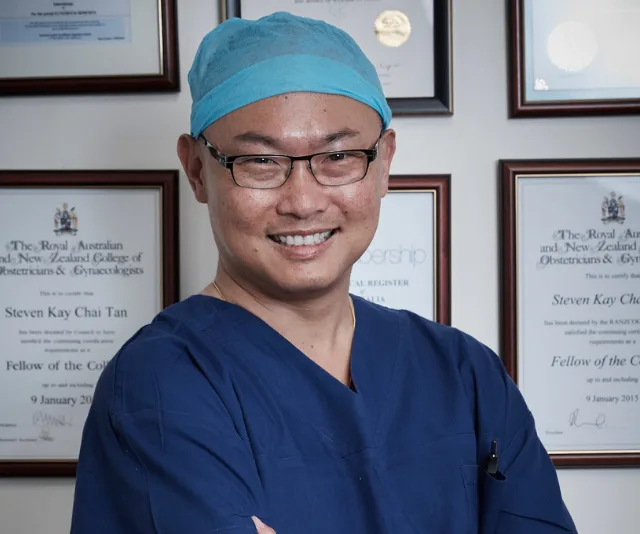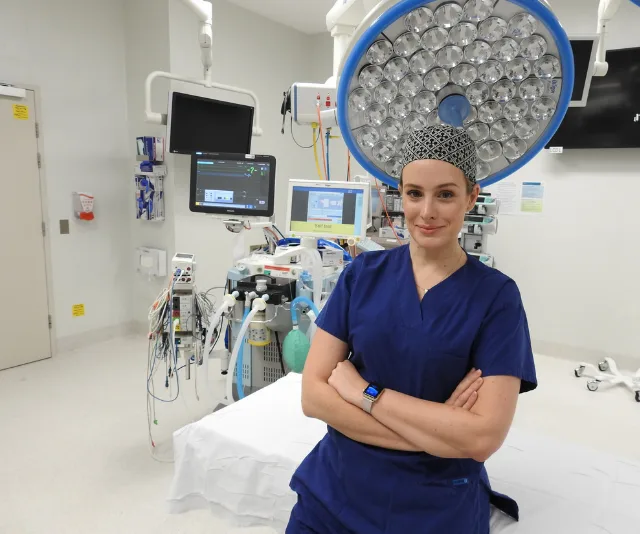In a first for Australian television, viewers will be able to see a caesarean section birth in real time, from start to finish in all it’s glory.
From your own loungeroom you’ll be able to witness every compelling moment from pre-operation preparation to the miracle moment when parents meet their baby in Channel 7’s Operation: Live on Sunday night.
As a mum who had four C-section deliveries, none of which was exactly the same, I am completely fascinated in seeing how this looks as a spectator.
The surgeon’s room, and what goes on there is so often off-limits, which is why Channel 7 and host, Melissa Doyle are so excited to demystify exactly what unfolds during a caesarean operation.

The operation will be performed at Sydney’s Mater Hospital on Sunday, February 10 by leading obstetrician and gynaecologist, Dr Steven Tan. Image: Supplied.
The operation will be performed at Sydney’s Mater Hospital on Sunday, February 10 by leading obstetrician and gynaecologist, Dr Steven Tan. A highly skilled surgeon, Dr Tan has delivered over 10,000 babies during his career and admits he’s been known to “shed a tear or two” during certain births.
“It is a wonderful job and it’s a pleasure and honour to do what I do. Words cannot describe the magic. It is truly a very special moment in time when parents have a beautiful child in their hands,” he explains.
Operation: Live will also feature expert commentary from specialist obstetrician and gynaecologist Dr Guy Skinner and cardiothoracic surgeon Dr Nikki Stamp who will explain the stages of the operation as they happen.
Dr Skinner worked as a country GP who ended up delivering babies due to the remote location of his practice which inspired him to pursue a career in obstetrics. Today he’s one of Melbourne’s busiest obstetricians delivering babies almost every day of the year.
Dr Stamp is one of only 11 female cardiothoracic surgeons in Australia. Her research has been published in numerous leading medical journals including the ANZ Journal of Surgery and the British Medical Journal. She also teaches medical students and surgical trainees.

OPERATION: LIVE will also feature expert commentary from cardiothoracic surgeon Dr Nikki Stamp who will explain the stages of the operation as they happen. Image: Supplied.
5 things everyone NEEDS to know about caesareans
1. Your ability to bond with your baby is the same as if you had a natural birth
GP Michelle Groves says you’ll still be able to feel that amazing connection, but you might need some additional help.
“After a C-section, the mother will have some pain in her lower abdomen, which can reduce mobility,” she explains.
2. The post-caesarean recovery time in hospital is not as long as it used to be
Michelle says, “Generally, three to five days is the average length of stay after having a C-section.”
It was not uncommon for women 20 or 30 years ago to be bedridden for up to a week.
“We have advances in medical and surgical treatments to thank for reducing our spell in hospital,” she says.
“But the majority of new mums will be up and about within an hour of the C-section and the midwife will always be on hand to help with lifting the baby to help with nursing
WATCH: Baby born inside amniotic sac. Continues after video …
3. There has been a rise in the trend of ‘maternal-assisted’ caesareans
This is when the mother helps to deliver the baby by lifting it out herself. If you want to do this, you’ll have to be sterilised and ‘scrub in’ like the surgeons, but it still carries a high risk of infection for your incision.
Let’s face it: getting involved in your own C-section is not for the faint-hearted!
4. Feeling very cold or shaking uncontrollably after a caesarean is harmless, and quite normal
It usually only lasts a couple of hours post-birth, but it can be scary if you’re not expecting it.
5. You can breastfeed straightaway!
“Provided the baby comes out in good condition, it is put on the mother’s breast pretty much as soon as it is delivered,” says obstetrician Dr Gino Pecoraro.
“Mum can cuddle and get the baby to nuzzle her breast and suck while the doctor is continuing with the surgery.”
OPERATION: LIVE airs SUNDAY, FEBRUARY 10 at 9.00pm on Channel 7

